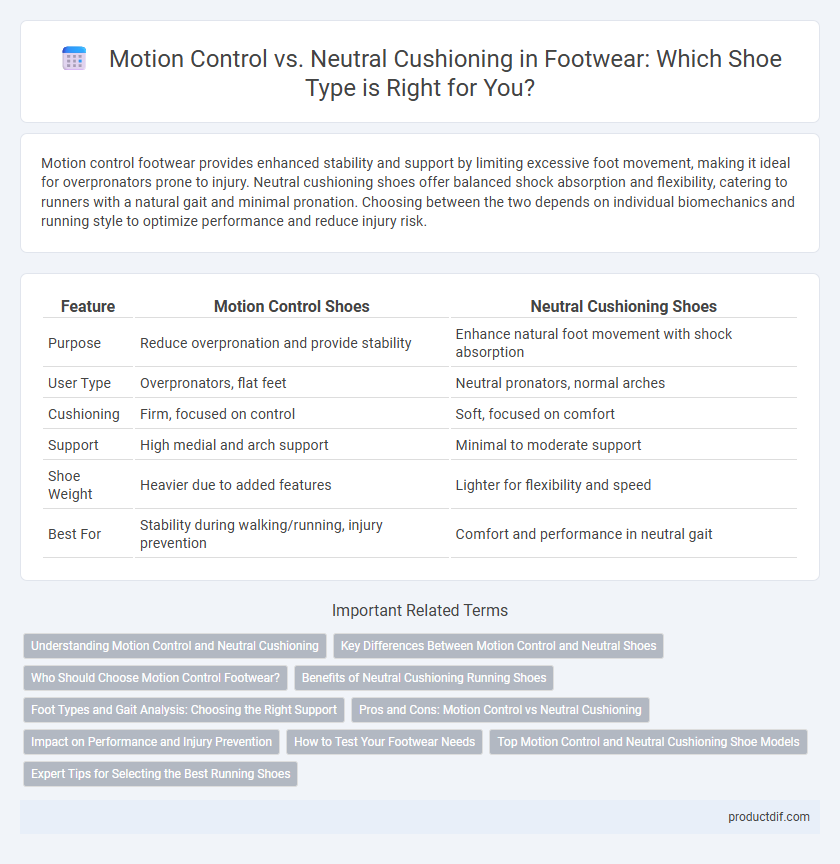Motion control footwear provides enhanced stability and support by limiting excessive foot movement, making it ideal for overpronators prone to injury. Neutral cushioning shoes offer balanced shock absorption and flexibility, catering to runners with a natural gait and minimal pronation. Choosing between the two depends on individual biomechanics and running style to optimize performance and reduce injury risk.
Table of Comparison
| Feature | Motion Control Shoes | Neutral Cushioning Shoes |
|---|---|---|
| Purpose | Reduce overpronation and provide stability | Enhance natural foot movement with shock absorption |
| User Type | Overpronators, flat feet | Neutral pronators, normal arches |
| Cushioning | Firm, focused on control | Soft, focused on comfort |
| Support | High medial and arch support | Minimal to moderate support |
| Shoe Weight | Heavier due to added features | Lighter for flexibility and speed |
| Best For | Stability during walking/running, injury prevention | Comfort and performance in neutral gait |
Understanding Motion Control and Neutral Cushioning
Motion control shoes are designed to stabilize the foot by controlling excessive pronation, providing firm support and reducing inward rolling during movement. Neutral cushioning footwear offers balanced shock absorption without extra support features, ideal for runners with a natural gait and minimal pronation. Choosing between motion control and neutral cushioning depends on individual biomechanical needs and running style for optimal comfort and injury prevention.
Key Differences Between Motion Control and Neutral Shoes
Motion control shoes feature rigid support structures and medial posts to prevent overpronation, providing enhanced stability for flat or low-arched feet. Neutral cushioning shoes offer balanced cushioning without extra support, ideal for runners with a normal gait or neutral pronation. The key difference lies in motion control shoes correcting excessive inward roll, while neutral shoes promote natural foot movement.
Who Should Choose Motion Control Footwear?
Motion control footwear is designed for overpronators who experience excessive inward foot rolling during gait, providing enhanced stability and support to reduce injury risk. Runners or walkers with flat feet or low arches benefit from motion control shoes to correct alignment and prevent ankle strain. Athletes with a history of plantar fasciitis or shin splints often choose motion control footwear to improve foot mechanics and promote efficient motion.
Benefits of Neutral Cushioning Running Shoes
Neutral cushioning running shoes provide enhanced shock absorption, reducing impact stress on joints and promoting a smoother stride. Designed for runners with a natural foot motion, they offer balanced support without restricting movement, encouraging efficient biomechanics. These shoes improve comfort during long-distance runs by evenly distributing pressure and minimizing fatigue.
Foot Types and Gait Analysis: Choosing the Right Support
Motion control shoes are ideal for overpronators with flat or low arches, providing enhanced stability and preventing excessive inward foot roll during gait. Neutral cushioning works best for runners with normal arches and a neutral gait, offering balanced shock absorption without altering foot motion. Accurate gait analysis and understanding foot type are essential to select the correct support, reducing injury risk and improving overall running efficiency.
Pros and Cons: Motion Control vs Neutral Cushioning
Motion control shoes provide enhanced stability and support for overpronators, reducing the risk of injuries such as plantar fasciitis and shin splints, but they can feel heavier and less flexible compared to neutral cushioning models. Neutral cushioning shoes offer lightweight comfort and a natural foot strike ideal for neutral runners, though they may lack the necessary support for those with pronation issues, potentially leading to overuse injuries. Choosing between motion control and neutral cushioning depends on individual gait analysis, foot shape, and injury history to optimize performance and reduce injury risk.
Impact on Performance and Injury Prevention
Motion control shoes provide enhanced stability and support, reducing excessive pronation and lowering the risk of overuse injuries, which is crucial for runners with flat or unstable feet. Neutral cushioning shoes offer balanced shock absorption and flexibility, promoting natural foot movement and benefiting those with normal arches in maintaining efficient gait mechanics. Choosing the appropriate footwear type significantly impacts performance by optimizing biomechanics and minimizing injury potential during physical activities.
How to Test Your Footwear Needs
To test your footwear needs, perform a gait analysis by observing your foot's pronation patterns during walking or running; overpronators benefit from motion control shoes that stabilize excessive inward roll, while neutral pronators require cushioned shoes for shock absorption. Use the wet test by wetting your foot and stepping on a flat surface to assess your arch type--flat or low arches suggest motion control shoes, whereas medium to high arches align with neutral cushioning. Visit specialty running stores equipped with pressure plates or force sensors for precise biomechanical evaluations to ensure the best match between foot structure and footwear technology.
Top Motion Control and Neutral Cushioning Shoe Models
Top motion control shoe models such as the Brooks Beast and Asics Gel-Kayano provide enhanced stability for overpronators by incorporating medial posts and structured support elements. Neutral cushioning shoes like the Nike Air Zoom Pegasus and New Balance Fresh Foam 1080 focus on shock absorption and comfort, catering to runners with a natural gait and minimal pronation. Selecting between motion control and neutral cushioning depends on individual foot biomechanics, with the former designed to correct excessive inward rolling and the latter emphasizing adaptive padding for those with neutral strikes.
Expert Tips for Selecting the Best Running Shoes
Selecting the best running shoes depends on understanding the differences between motion control and neutral cushioning. Motion control shoes provide extra stability and support for overpronators, reducing injury risk by correcting excessive foot motion. Neutral cushioning shoes suit runners with a natural gait, offering balanced shock absorption and flexibility for enhanced comfort and performance.
Motion control vs neutral cushioning Infographic

 productdif.com
productdif.com